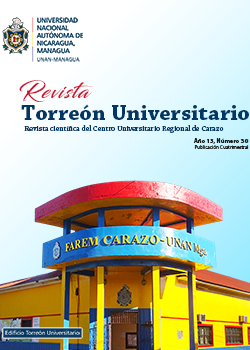Non-pharmacological diagnostic and therapeutic approach, obsessive-compulsive disorder in adults. Systematic review
DOI:
https://doi.org/10.5377/rtu.v13i38.19123Keywords:
Obsessive compulsive disorder, cognitive behavioral therapy, adultsAbstract
The purpose of this article is to synthesize evidence of the non-pharmacological diagnostic and therapeutic approach in adults with Obsessive Compulsive Disorder (OCD) through a systematic review, including 9 case reports, through MEDLINE, PUBMED, Google Scholar, Scielo, institutional repositories, thesauri: “Obsessive Compulsive Disorder AND Adult NOT Children”. Using inclusion criteria: Scientific articles published between 1990-2023, published in Spanish and English. Results: 9 articles included (nine patients) published in Spanish, eight published in Spain with an average age of 29.6 years, 68% of cases ranging from 20.8 to 38.4 years, five patients in the second decade of life at the time of therapy and three in the third decade. Mean age of onset of symptoms 21.12 years, onset of symptoms related to a stressful life event, female sex the oldest affected. The pattern of intrusive thoughts prevailed. Psychotherapy combined with acceptance and commitment techniques was effective in eliminating psychological rigidity, frequency of once a week with duration between 45 to 60 minutes, an average duration of 23.3 weeks, with a range of 8 weeks to 48 weeks, depending on the severity of their symptoms. Conclusions: intrusive thoughts and female sex are prevalent aspects, it affects young population, psychological therapy is effective, patients show improvement of obsessive compulsive symptoms even reaching subclinical levels, cognitive-behavioral therapy was the best directed by a therapist, with weekly sessions of one hour, face to face, from 8 to 43 weeks duration.
Downloads
References
Abramowitz, JS, Taylor, S. y McKay, D. (2009). Trastorno obsesivo compulsivo. The Lancet, 374 (9688), 491–499. https://doi:10.1016/s0140-6736(09)60240-3
Brock, H., & Hany, M. (2022). Obsessive-Compulsive Disorder. In StatPearls. StatPearls Publishing. https://www.ncbi.nlm.nih.gov/books/NBK553162/#article-26069.s9
Baer L. (1994). Factor analysis of symptom subtypes of obsessive-compulsive disorder and their relation to personality and tic disorders. The Journal of clinical psychiatry, 55 Suppl, 18–23. https://pubmed.ncbi.nlm.nih.gov/8077163/
Bloch, M. H., Landeros-Weisenberger, A., Rosario, M. C., Pittenger, C., & Leckman, J. F. (2008). Meta-analysis of the symptom structure of obsessive-compulsive disorder. The American journal of psychiatry, 165(12), 1532–1542. https://doi.org/10.1176/appi.ajp.2008.08020320
Behobi Baudou, Walter A., García, Fernando, & Fernández-Álvarez, Héctor. (2013). Psicoterapia cognitiva individual del TOC. Salud mental, 36(4), 347-354. http://www.scielo.org.mx/scielo.php?script=sci_arttext&pid=S0185-33252013000400010&lng=es&tlng=es.
Carrió Rodríguez, C. (2004). Efectos a largo plazo del tratamiento cognitivo en un caso de trastorno obsesivo compulsivo. Revista De Psicopatología Y Psicología Clínica, 9(2), 99–121. https://doi.org/10.5944/rppc.vol.9.num.2.2004.3972
Drubach D. A. (2015). Obsessive-compulsive disorder. Continuum (Minneapolis, Minn.), 21(3 Behavioral Neurology and Neuropsychiatry), 783–788. https://doi.org/10.1212/01.CON.0000466666.12779.07
Fals-Stewart, W., & Lucente, S. (1994). Behavioral group therapy with obsessive-compulsives: an overview. International journal of group psychotherapy, 44(1), 35–51. https://doi.org/10.1080/00207284.1994.11490733
Fernández-Montes Rodríguez, I., & García Sánchez, S. (2019). TRATAMIENTO COGNITIVO-CONDUCTUAL EN UNA ADOLESCENTE CON TRASTORNO OBSESIVO-COMPULSIVO. Revista De Casos Clínicos En Salud Mental, 7(1). https://ojs.casosclinicosensaludmental.es/index.php/RCCSM/article/view/43
Leckman, J. F., Grice, D. E., Boardman, J., Zhang, H., Vitale, A., Bondi, C., Alsobrook, J., Peterson, B. S., Cohen, D. J., Rasmussen, S. A., Goodman, W. K., McDougle, C. J., & Pauls, D. L. (1997). Symptoms of obsessive-compulsive disorder. The American journal of psychiatry, 154(7), 911–917. https://doi.org/10.1176/ajp.154.7.911
Pineda Gea, F., Téllez Ramos, C. M.., & Gutiérrez Aburto, R. A... (2023). Metodología Aplicada en la Redacción de Trabajos Monográficos de Tipo Revisión Sistemática. Revista Ciencia Y Tecnología El Higo, 13(1), 2–19. https://doi.org/10.5377/elhigo.v13i1.16371
Downloads
Published
How to Cite
Issue
Section
License
Copyright (c) 2024 National Autonomous University of Nicaragua, Managua

This work is licensed under a Creative Commons Attribution-NonCommercial-NoDerivatives 4.0 International License.
The authors who publish in this journal agree to the following terms.
- The author or authors of the articles, essays or research grant the National Autonomous University of Nicaragua, Managua (UNAN-Managua) the editing rights (copyright) of the submitted work, therefore the University has the exclusive right to publish the article for the entire copyright period.
- These copyrights/authors authorize Torreón Universitario Magazine and the University to edit and disseminate/publish the article in said Magazine, including printed and electronic reproduction, storage, retrieval and any other type of publication, and sources of secondary information as services. of summaries and databases, they also empower it to protect the article against unauthorized use for dissemination by printed or electronic media (PDF, HTML, EPUB, XML or others).
License for use of content
The magazine uses the Creative Commons Attribution-NonCommercial-NoDerivs 4.0 International License.
Under this statement:

This journal is licensed under a Creative Commons Attribution-NonCommercial-NoDerivatives 4.0 International License. It can be copied, distributed and transmitted publicly as long as the author and source are cited (Revista Torreón Universitario), it should not be modified or used for any commercial purpose. The full license can be found at http://creativecommons.org/licenses/by-nc-nd/4.0/.



